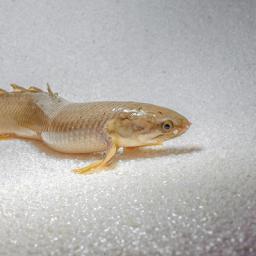Scientists raise air-breathing fish on land to test evolution
 Among the more interesting aquatic species on our earth is Polypterus senegalus ("Bichir"), a modern African fish that has lungs for breathing air, and stubby fins. It can use the to pull itself along on land for short periods of time. That makes it an good candidate for research into previously unknown aspects of evolution. So scientists have raised a bunch of them out of water for eight months to better understand how ancient creatures may have transitioned to life on land. Have a look here for a picture of the species.1
Among the more interesting aquatic species on our earth is Polypterus senegalus ("Bichir"), a modern African fish that has lungs for breathing air, and stubby fins. It can use the to pull itself along on land for short periods of time. That makes it an good candidate for research into previously unknown aspects of evolution. So scientists have raised a bunch of them out of water for eight months to better understand how ancient creatures may have transitioned to life on land. Have a look here for a picture of the species.1"The researchers discovered the bichir raised on land were dramatically different than those raised in water. The land-raised fish lifted their heads higher, held their fins closer to their bodies, took faster steps and undulated their tails less frequently and had fins that slipped less often than bichir raised in water. These land-based fish also underwent changes in their skeletons and musculature that likely paved the way for their changes in behavior."The Bichir is a pretty interesting fish. From Wikipedia, "Bichirs possess paired lungs which connect to the esophagus via a glottis. They are obligate air-breathers, requiring access to surface air to breathe in poorly oxygenated water. Their lungs are highly vascularized to facilitate gas exchange. Deoxygenated arterial blood is brought to the lungs by paired pulmonary arteries, which branch from the fourth efferent branchial arteries (artery from the fourth gill arch), and oxygenated blood leaves the lungs in pulmonary veins. Unlike most lungfish and tetrapods, their lungs are smooth sacs instead of alveolated tissue. Bichirs are unique in that they breathe using a recoil aspiration."
1 So, a bichir is worth a thousand words? Sorry.
[2014-09-17 17:54: Typo fixed: bichir, not bichr. And definitely not bitcher.]